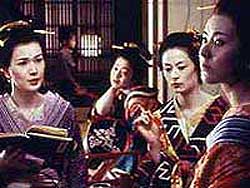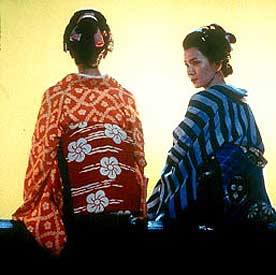From a script by Akira Kurosawa, & a novel by Sugoro Yamamoto, Kei Kumai's The Sea is Watching (Umi Wa Miteita, 2002) is as un-Kurosawa-like as any Japanese period film can be. Female characterization dominates, rather than his usual Seven Samurai character array. However, in keeping with Kurosawa's masculinist preferences, he depicts the lives of oiran or prostitutes in a small village-like entertainment district.
 Kurosawa's script shows these women as variously grasping & greedy, loving & self-sacrificing; it strongly peddles the "hooker with a heart of gold" mentality. Director Kei Kumai is sympathetic to such material, several of his films having a similar romantic take on suffering, nurturing, loving, psychologically damaged womanhood. Kurosawa's script shows these women as variously grasping & greedy, loving & self-sacrificing; it strongly peddles the "hooker with a heart of gold" mentality. Director Kei Kumai is sympathetic to such material, several of his films having a similar romantic take on suffering, nurturing, loving, psychologically damaged womanhood.
It's a nice little film yet I can't help but think Kurosawa worked on this script primarily to contradict the recurring criticism that he was incapable of writing female characters. He proves here that he could do so, even if ultimately he has merely constructed a male fantasy of heroic prostitution.
In the better pleasure districts there is aesthetic artifice which the tawdry imitations strove to convey in degraded ways. The "movie set" feeling of the constructed street captures this sense of artifice very nicely. Such secondary pleasure districts or brothel streets were frequently on land that flooded periodically, & this quiet film's biggest event will be the concluding flooding of the street. This provides some striking images for the conclusion, but in the main this is not a film of exciting adventure or event.
The primary tale among several intersecting portraits regards Oshin (Nagiko Tono) who falls in love with a young samurai (Hidetaka Yoshioka) of such sweet disposition that she never imagines his loving attentions are not true love. All the dreamy prostitutes unite to support her so that she no longer has to take in customers but can prepare to marry the young samurai, who will of course disappoint their collective fantasy of one of them ending up happy, when he marries someone appropriate to his class.
Truly wonderful acting overcomes the scripted stereotyping & renders some of these portraits of fallen lives fairly moving. But it's also a film void of honesty, depth, or truth.
The reality of such women's lives was nothing like what is shown here. Many were turned out of the brothels when they became syphilitic & would have their disintegrating sore-scarred faces "rebuilt" with make-up & wax in order to turn tricks under cover of darkness, on dry riverbeds or pissed-in alleyways, until they were either killed or died of illness & exposure.
The better pleasure districts provided hostels for diseased women to die in, abandoned by all friends but moderately cared for due to government regulation. But the poorer & less well regulated places like the one shown in this film inevitably had a nightmarish dimension that romanticizing patrons such as Kurosawa have always refused to acknowledge. If Masahiro Shinoda or Nagisa Oshima had tackled this subject it might have been powerful, but Kurosawa & Kumai are clueless.
copyright © by Paghat the Ratgirl
|

 Kurosawa's script shows these women as variously grasping & greedy, loving & self-sacrificing; it strongly peddles the "hooker with a heart of gold" mentality. Director Kei Kumai is sympathetic to such material, several of his films having a similar romantic take on suffering, nurturing, loving, psychologically damaged womanhood.
Kurosawa's script shows these women as variously grasping & greedy, loving & self-sacrificing; it strongly peddles the "hooker with a heart of gold" mentality. Director Kei Kumai is sympathetic to such material, several of his films having a similar romantic take on suffering, nurturing, loving, psychologically damaged womanhood.